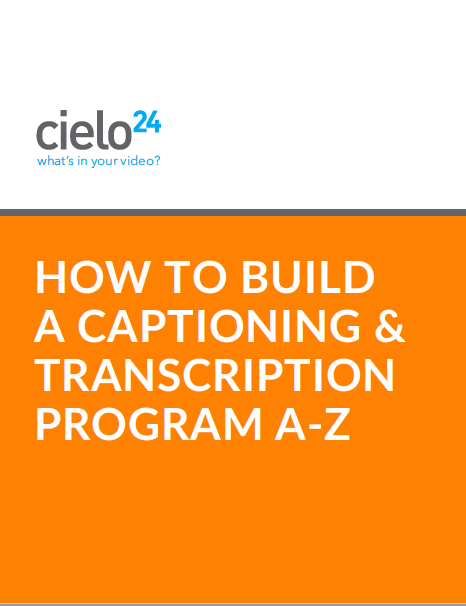Closed Captioning for iOS Technology Businesses understand that the world is rapidly switching to mobile…

Instructional Designers are the Linchpin for Campus Technology Adoption
Instructional Designers are the linchpin for campus technology adoption. When it comes to the evolution of technology and how universities adapt, Instructional Designers are often leading or partners in the lead on technology evolution and adoption. Technology is ever-shifting, and learning program, resources, and materials must also shift simultaneously.
Not only is this shift imperative for universities trying to continuously attract an engaged their student body, but as professors build new courses these learning tools must all be made accessible. Instructional Designers have become an integral part of the technology ecosystem.
But these adjustments aren’t simply updating text-based materials, like books, web copy, or worksheets. The Association for Educational Communications and Technology (AECT) defines the Instructional Designer’s responsibilities as “the theory and practice of design, development, utilization, management, and evaluation of processes and resources for learning.”
Keyword there is “theory.” Instructional Designers have to research, analyze and predict the changes that will be needed to meet the advancements of technology in the learning environment. No easy feat.
“…the theory and practice of design, development, utilization, management, and evaluation of processes and resources for learning.”
– The Association for Educational Communications and Technology (AECT)
As explained by Purdue University, “Instructional designers are paramount in the process of learning. They are tasked with redesigning courses, developing entire courses or curriculums and creating training materials, such as teaching manuals and student guides… Essentially, instructional designers implement theory and research processes to design and implement learning materials that produce greater outcomes for a specific group of people.”
Instructional Designer Impact on Video Campus Technology Adoption
Instructional Designers are often leading the charge on ensuring all video learning resources are captioned – which is required by federal law according to the Americans with Disabilities Act (ADA). But they aren’t simply captioning videos – they’re creating an entire video captioning system for their university.
Instructional Designers are researching all captioning platforms, identifying which ones align with their technology and video players, building out policy and processes across departments, and ensuring that the video captioning experience is universal for all students across the board.
Campus Video Technology
Audio and video captions and transcripts serve additional functions for Instructional Designers, allowing them to take media files and repurpose them into new course materials and learning resources for their student body. They also use transcripts for media insights – like keywords, speaker identification and analysis, and new course offerings that might be needed due to gaps in learning topics.
Areas Impacted By Video Technology

1. University and Departmental Infrastructure
Instructional Designers are putting systems in place on both the procurement side and course design side. They create policies and procedures that ensure only accessible technologies are acquired by the university. And they then create a one-stop resource that details everything accessibility and universal design. Their goal? To build accessibility into university policies, procedures, and course offerings in advance so they aren’t retroactively correcting accessibility gaps.
They often build a website or webpage, run by the IT Accessibility office or a similar disabilities services office, to outline this infrastructure, including accessibility policy and procedures and guidance for educators on how to design courses inclusively.

2. Outreach
Instructional Designers are responsible for collaborating and supporting all faculty and staff at the university in their accessible course design efforts. They first must ensure direct communications with faculty about course design, often providing a list of “essential questions” to address when designing course materials and structure. Secondly, they create a strategy for discussing budget requirements, explaining the benefits of universal design for all students and highlighting its ability to mitigate future financial loss. And finally, they are responsible for addressing accessibility when doing RFPs, RFIs, and new vendor acquisition. Vendors will not automatically build accessibility into their product. Instructional Designers will have these conversations with third party companies before anything is signed.

3. Empowerment
Instructional Designers, finally, understand that accessibility cannot be achieved by themselves alone, but rather that everyone on campus has a role in the process. They encourage everyone to recognize their roles and responsibilities and showcase the champions who are doing a good job in embracing accessibility policy and procedures. They even build a team of people who focus on helping to drive accessibility forward and sharing their success stories. They think about which stories will inspire action; the ones about mitigating risk, the ones about real students with disabilities, and the stories about successful, accessible course design.
How cielo24 Works with Instructional Designers to Make University Video and Audio Accessible
 cielo24 proudly works with universities across the globe to make media accessible! Other benefits of using captions and transcripts to make media accessible are increased engagement, improved SEO, and increase conversions for digital content.
cielo24 proudly works with universities across the globe to make media accessible! Other benefits of using captions and transcripts to make media accessible are increased engagement, improved SEO, and increase conversions for digital content.
Test our cutting-edge captioning and transcription platform through a Free Trial. You can test drive any service level to make sure you’re getting the right fit for your organization.
Begin captioning immediately at less than $1/minute. Or contact us for a Free Enterprise trial based around your unique business needs. Or contact us online or call us at 1-855-243-5624.
- One free podcast recording into video caption and transcript
- Video Wrapper 3.0 – our exclusive interactive video player
- Media intelligence – topics, tags, keywords and more – all displayed through the interactive video player
- Integrations – we can integrate the trial directly through your video platforms, so you understand how the integrations work




